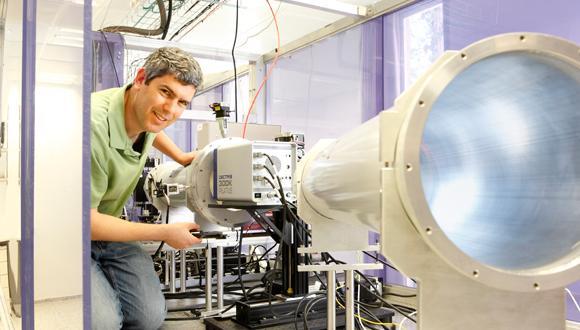When Biology Meets Physics
One of Israel’s most promising young biophysicists, Dr. Roy Beck-Barkai of TAU’s Raymond and Beverly Sackler Faculty of Exact Sciences, is endeavoring to understand the behavior of groups of biomolecules and how they organize themselves into functional living systems. Greater understanding of these interactions could lead to better medical treatments and diagnostic tools, and novel ways of delivering drugs precisely where they need to go in the body.
Homegrown at TAU, Beck-Barkai completed his BSc degree in physics and computer science and an accelerated PhD program in physics. Seeking a way to combine physics with his love of biology and medicine, he completed a post-graduate degree at the University of California, Santa Barbara, in one of the best biophysical laboratories in the world. After four years in California, Beck-Barkai received a recruitment offer from TAU that he couldn’t resist – a million dollar plus laboratory that is now one of the most cutting-edge labs on campus. For Beck-Barkai, an interdisciplinary approach to research is critical, noting that “TAU offers the best environment for me to do great interdisciplinary research.”
Molecular Lego
At TAU, Beck-Barkai and his team of gifted and motivated students are focusing on the synergy between physics and biology – a new research area lying between the physics of individual molecules and the biology of organized living systems. “Take the basic building blocks of a Lego set,” explains Beck-Barkai. “You can design an awesome toy machine with them such as a car or a spaceship, because the rules are simple.” However, he notes, biological building blocks and the interactions between them are far more complex. They are encoded in the physical interactions between molecules that are essential to life – proteins, nucleic acids, fats, carbs, etc. “The analogy works if we think of how these building blocks create by themselves beautiful machines in our body,” says Beck-Barkai.
Biophysics as an interdisciplinary field is trying to model these complicated physical materials and their interactions from the bottom up, so to speak, notes Beck-Barkai. “If we can understand how biological building-blocks ‘talk’ or ‘communicate’ with one another to form necessary complexes in our body, we can hopefully anticipate what makes them malfunction and how to fix them.”
A major obstacle in this research, however, is the fact the biomolecules are minute and must be analyzed on the nanoscale (one nanometer is one millionth of a millimeter.) They cannot be seen with regular optical microscopy without been modified, and these modifications change the interactions between the molecules, and therefore don’t give a truly accurate picture of what is occurring inside.
The Science of Solutions
In response, Beck-Barkai’s team invests much effort in purifying special building blocks from native tissues or using biochemistry and bacteria as a factory to produce the materials they wish to study. To view the materials, the team has invented a unique small angle X-ray scattering machine – the only one of its kind in the world. The system radiates the samples with very intense x-ray and records its scattering at small angles. Analyzing this scattering data helps to deduce the structures and interactions of the nano-objects in the sample.
The advantage of this technique, says Beck-Barkai, is that “we can conduct these experiments in solutions with water that mimic the environment inside the cell.” In addition, by using this system the team can find the correlation between the nano-structures and the environmental conditions surrounding them. This is critical as it allows them to model the dominant interactions affecting the nano structure. “The inspiration is to understand how these basic ingredients contribute to the malfunctioning in disease states,” Beck-Barkai says, adding that the team is collaborating with medical scientists to try to answer their questions with new insights. One such project is being conducted jointly with TAU’s nanomedicine expert Prof. Dan Peer, involving the development of lipid-based drug targeting therapy. By combining fields and expertise, these TAU researchers are paving the way for more effective medical treatment, diagnosis and drug development – highlighting both the focus on and merits of TAU’s interdisciplinary emphasis.
Dr. Roy Beck-Barkai’s research is supported by Jill and Jack Gerber of the UK, with additional funding from the Raymond and Beverly Sackler Institute of Biophysics, the Israel Science Foundation and a European Union Carrier Integration Grant.






